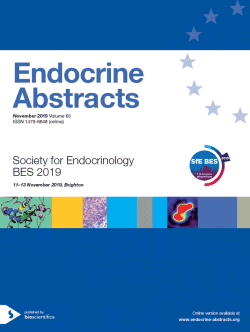
Society for Endocrinology BES 2019
Brighton,
United Kingdom
11 Nov 2019 - 13 Nov 2019

Abstracts
FEATURED CLINICAL CASE POSTERS
ea0065cc1 | FEATURED CLINICAL CASE POSTERS | SFEBES2019
Double somatic mutations of CTNNB1 and GNA11 in aldosterone producing adenomas (APAs) presenting in puberty, pregnancy or menopause
Zhou Junhua , Storr Helen , Cottrell Emily , Cabrera Claudia , Argentesi Giulia , Wu Xilin , Goodchild Emily , Azizan Elena , Brown Morris J
ea0065cc2 | FEATURED CLINICAL CASE POSTERS | SFEBES2019
Splice-site mutations in the melanocortin-2 receptor accessory protein that lead to early-onset familial glucocorticoid deficiency type 2
Qamar Younus , Maharaj Avinaash , Chan Li , Deeb Asma , Metherell Louise
ea0065cc3 | FEATURED CLINICAL CASE POSTERS | SFEBES2019
A rare sclerosing bone dysplasia
Casey Helen , Stirling Angus , Gallacher Stephen , Gallagher Andrew
ea0065cc4 | FEATURED CLINICAL CASE POSTERS | SFEBES2019
Multiple endocrine neoplasia type 1 (MEN1) mosaicism caused by a c.124G>A variant in the MEN1 gene
Mauchlen Rachel , Carty David , Talla Maria , Drummond Russell
ea0065cc5 | FEATURED CLINICAL CASE POSTERS | SFEBES2019
Pituitary carcinoma with hepatic metastasis hypersecreting ACTH precursors masquerading as Nelson syndrome after bilateral adrenalectomy for refractory Cushing’s syndrome
Dhakshinamoorthy Barkavi , Elsaify Wael , Nag Sath
ea0065cc6 | FEATURED CLINICAL CASE POSTERS | SFEBES2019
Severe aortic regurgitation associated with low cumulative dose cabergoline in prolactinoma: a case report
Moore Sacha , Nana Melanie , Dixon Anthony
ea0065cc7 | FEATURED CLINICAL CASE POSTERS | SFEBES2019
Arg798Ter BRIP-1 mutation associated with metastatic phaeochromocytoma
Gohil Shailesh , Barwell Julian , Levy Miles
ea0065cc8 | FEATURED CLINICAL CASE POSTERS | SFEBES2019
Well-differentiated grade 3 neuroendocrine tumors (G3NET) – single centre experience from the UK
Venkataraman Hema , Lithgow Kirstie , Smith Stacey , Kemp-Blake Joanne , Vickrage Suzanne , Hughes Simon , Shetty Shishir , Elshafie Mona , Gadvi Rakesh , Kharkhanis Salil , Ayuk John , Geh Ian , Shah Tahir
ea0065cc9 | FEATURED CLINICAL CASE POSTERS | SFEBES2019
A novel inherited epigenetic cause of pseudohypoparathyroidism type 1b
Crabtree Thomas , Dixit Abhijit , Johnson Katie , Chokkalingam Kamal
ea0065cc10 | FEATURED CLINICAL CASE POSTERS | SFEBES2019
Cognitive impairment reversed by cinacalcet administration in primary hyperparathyroidism: a case report
Timmons Joseph , Manners Rachel , Bailey Matthew , McDougall Claire



